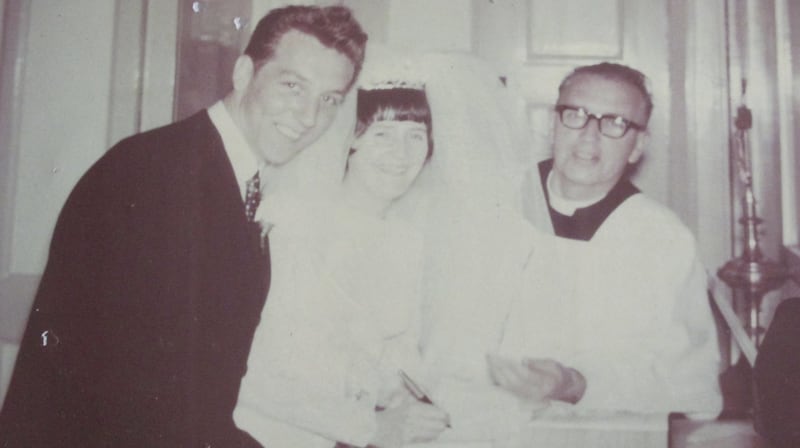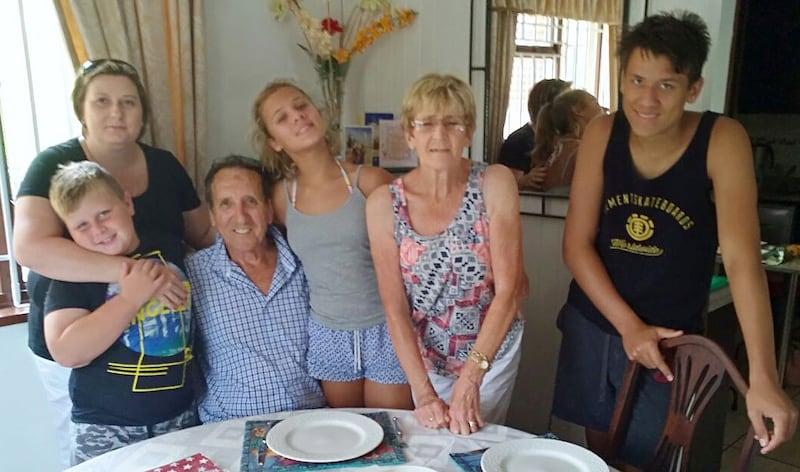Jimmy and Anne McClelland – now retired and living in the coastal town of Amanzimtoti, outside Durban in South Africa – met at the Orpheus Ballroom in York Street in Belfast in 1964.
Both were from north Belfast, Anne a Catholic, Jimmy a Protestant and Orange Order member. They fell for each other quickly.
“We just got on so well,” says Anne.
They tell their story in Exiles for Love, a book published by the Northern Ireland Mixed Marriage Association, about couples who felt the only escape from the bitterness was to quit Northern Ireland.
When they decided to get married Anne asked Jimmy how he felt about “turning” – converting to Catholicism.
Said Jimmy: “I told her I had no intention of ‘turning’. She said okay and that was the end of that.”
But not quite. Anne went to confession to a priest, a curate in Greencastle in north Belfast. She remembers: “He went crazy. There’s no other way to describe it. He ordered me out of the confessional, out of the chapel and started haranguing me outside the church. He even stopped two old dears on the main road telling them that I was no good, all my children would be Protestants and that my Protestant boyfriend was no good and would rule the Protestant roost if we got married. So much for the secrecy of the confessional.”
The priest went to her home persuading others in the family that it would be best if they broke up.
Luckily, another priest, Fr Scott from St Mary’s Church in central Belfast came to the rescue persuading her family that Jimmy was a “good man who would look after me and respect me and my religion”.
Fr Scott married them in St Mary’s in a ceremony attended by both Catholics and Presbyterians, after which they began settling into married life, Jimmy working as an electrician. But then the Troubles intruded.
It was made clear in the area where they lived that Catholics weren’t welcome. Jimmy was informed his “Taig wife” wouldn’t assist his career prospects.
“We decided to emigrate. Our family’s future was most important to us and that future lay 6,000 miles away,” says Anne.
Now Jimmy goes to Mass with Anne most Saturdays. “I started when the children were young and we went as a family and just carried on from there. I find it a comfort and a joy, but I have no need to ‘turn’. I think more about turning to God.”

Jimmy adds: “We learned that making a mixed marriage in Northern Ireland was really about giving up. Giving up friends, extended family and even home. We gave up the lot, but I can say that it was worth it.”
*****
The Northern Ireland Mixed Marriage Association (Nimma) has been in existence for 46 years. With secularism and the buffeting religion has taken, one might think it is no longer needed, but one of its key workers believes that is far from the case.
“We in Ireland have always bragged about the extended Irish family, but all you need is one bigot in the family sitting in the corner to throw a spanner in the works. If granny hates Catholics or Protestants then the trouble can start,” says Paul McLaughlin.
Ken Dunn, one of the founding members of Nimma in 1974, and its chairman, agrees.
“We were convinced at the start of the association that after 10 years we would have it all sorted,” he says. “We were totally and utterly wrong.”
Dunn reckons the Catholic Church’s former position on mixed marriages is one of the “principal reasons” there is not a united Ireland, but we will come back to that.
A member of the Church of Ireland, he met his Catholic wife, Maura, in the late 1960s at Queen’s University. He was a physicist while she worked in administration, their romance blossoming as the Troubles were cranking up.
When they decided to get married there was opposition, especially from his family. “But we ploughed ahead anyway and we’ve now been married 45 years ... People eventually caught up with us.”
McLaughlin is unusual in that he wasn’t in a mixed marriage, but is now. He converted to the Church of Ireland 14 years ago while his wife, Julie, remained a Catholic. “Now we don’t talk for a fortnight every July,” he jokes, referring to the marching season.
His conversion was partly prompted by some differences with the local Catholic hierarchy over the closure in 2001 of St Joseph’s Catholic Church in Sailortown in Belfast’s docklands.
He also describes himself as a pre-Vatican II “traditionalist” and likes the high church ritual of St George’s Church of Ireland on Belfast’s High Street. Julie joins him there for Easter and Christmas services.

“I still believe everything I believed when I was a Catholic. I am actually still a Catholic, just an Irish Catholic,” he says.
As the sole Nimma staff member, he is kept very busy, although there are dozens of volunteers to assist. People, some from the Republic, contact Nimma for advice on a range of issues: where a child should be baptised; wills with cases where “grandparents or the parents want land to remain in the religion it always was in”; whether to attend integrated, Catholic or state schools; where to live, where to get married; and in the more serious cases about fear of paramilitaries.
Being in a mixed marriage during the Troubles could be particularly fraught. That isn’t such a problem now, but it can still rear its venomous head.
Three years ago a number of Catholic families in a specially created mixed social housing estate off the Ravenhill Road in east Belfast were forced to leave their homes due to intimidation by the Ulster Volunteer Force.
Such difficulties generally don’t afflict the middle class, but those in public housing can be vulnerable, says McLaughlin.
*****
Nimma has an informative website which provides many practical answers to problems. With support from the Department of Foreign Affairs in Dublin it has published three books: Mixed Emotions, stories about mixed marriages; Both Sides Now, stories by the children of these marriages; and most recently, Exiles for Love, about people in mixed marriages who felt the best way to resolve their challenges was to leave Northern Ireland.
“A lot of people just want someone to listen to them; they like to have a sounding board. Often I am the first person they can talk to about it because they can’t talk to family,” says McLaughlin.
“I have heard most of the stories before, and I am there to assure them that their experience is not unique, and that it is certainly not the end of the world, and problems can be overcome,” he adds.
“I have seen situations where, for instance, a grandfather would not acknowledge a grandchild, and within weeks of seeing the little young one that has gone – love can conquer anything.
“But then you can have more subtle situations where people are shunned or spoken to or dealt with coldly by family members. We all know what families are like. You can have a row at a wake quicker than you would at a football match. That is just the nature of the Irish psyche.
“Such situations have reduced because we have managed to put away a lot of the restrictions and rules that forced people to confront the other denomination.”
There are times where there is no resolution, however. “On many occasions I have had to say to couples if people won’t come with you, you have to go on without them. And there are people who just won’t compromise. You do get family members who have to be left behind because they are not going to change.
“Our job is to say to young people who are nervous and anxious and very apprehensive about the future, that it may seem quite dark at the moment but believe me it will be OK.”
*****
As Nimma’s historian as well as its chairman, Ken Dunn explains how the problems go back to the Reformation and the Council of Trent 1545-1563, and the start of the Catholic-Protestant divide. This had its more modern manifestation when the Catholic Church’s introduced Ne Temere in 1908. In essence it meant that children in mixed marriages must be reared as Catholics.
He cites the case of Agnes and Alexander McCann, who were married in Antrim Presbyterian Church in 1908. They moved to Belfast where Alexander, the Catholic in the relationship, was advised by a priest that they were living in sin and must marry in front of a priest. By that stage they had two children.
Agnes, a Presbyterian, considered they were properly married and refused. In October that year Alexander and the two children, disappeared. Dunn tells the poignant story of Agnes roaming the streets of Belfast asking passersby if anyone had seen “her babies”.
The issue provoked riots and protests in Belfast, and protests in Dublin, Edinburgh, Glasgow, London, and also in Australia, Canada and New Zealand.
Agnes never saw her children again. Much later it emerged they were taken to the United States, where the family settled in Pittsburgh, Pennsylvania.
This was around the time of the great parliamentary and political battles to achieve Home Rule for Ireland. Dunn explains how in 1916 Colonel Wallace, grand master of the Orange Order – which opposed mixed marriages, and still does – used Ne Temere to declare that the “decree is final proof that Home Rule is Rome Rule”.
Had Home Rule happened, Dunn reckons, over time and perhaps peacefully a united Ireland would have followed. Hence his argument that the Catholic Church has a lot to answer for in terms of how the unity issue has unfolded over the past 100 years.
Ne Temere was ditched in 1970, with a further liberalisation in 1983 in Ireland when a new code of canon law was adopted by the Irish bishops, whereby marriages could take place in the bride’s church with both clergy present and participating and that all, some or none of the children would be brought up as Catholics.
Dunn says that the former primate, the late Cardinal Tomas O Fiaich pushed through that reform against strong resistance from some of the bishops.
He recalls regular conversations with the cardinal about that struggle. “Was it rough? I asked him. ‘Rough?’ he said. ‘I found myself thumping my fist on the table and shouting at them’.”
McLaughlin says we may be entering 2021 but problems over mixed marriage haven’t gone away. There are still cases where a taboo applies to two people being in love if one is Catholic, one is Protestant. “It sounds crazy in the 21st century but unfortunately some things are so deep-seated. And it isn’t just about religion, it is also tribal. The roots of these problems go back 400 years.”











